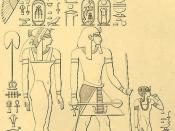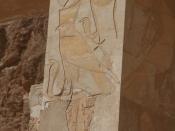Queen Hatshepsut was an astonishing king. She was the first female ever to claim the Egyptian throne and announce herself pharaoh. In order to do this, first she had to legitimise her claim. She believed she had political, social and religious reasons to claim the throne and used these along with half-truths to legitimise her rule.
Hatshepsut believed that she should have been king when her father died and there for believed that she had rights to the throne from the god Amun. She used religion as propaganda in legitimising her role. This was in particular with her relationship to Amun. Hatshepsut claimed that she was the divine conception of Amun. She claimed that Amun had visited her mother Queen Ahmose while she was sleeping and held an ankh symbol under her nose and this made her pregnant with Hatshepsut and made Amun the father. This is an example of religious propaganda and helped to legitimise Hatshepsut's claim to the throne as it showed that she had been chosen by Amun himself who was the highest god and therefore the god who chose the pharaoh.
Another example of religious propaganda that Hatshepsut used was the oracle of Amun. This was inscribed at Hatshepsut's temple in Karnak. She claimed that she received an oracle from Amun announcing that she was to be king. This again showed that Hatshepsut was chosen by the gods and gave her legitimacy in becoming pharaoh.
Hatshepsut also demonstrated a relationship with other gods. She did this by constructing shrines to other gods. This showed that she had a relationship with the other gods and was favoured by them and if many gods favoured her she had a right to be pharaoh.
Before Hatshepsut's claim to the throne as pharaoh she also used religious propaganda in her...


